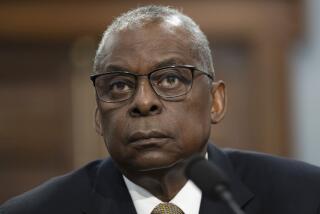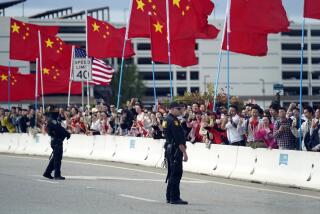Asia-Pacific Unity Off to Slow Start in Wake of Region’s 1st Conference : Pacific Rim: Several key countries were absent from last week’s meeting. But there were some signs of progress.
- Share via
CANBERRA, Australia — An optimist might sum up the results of the Pacific region’s first attempt to cooperate on a governmental level by citing the ancient Chinese proverb, “A journey of 10,000 miles begins with a single step.”
A pessimist would note that the 27 ministers from 12 nations, including three U.S. Cabinet secretaries led by Secretary of State James A. Baker III, restricted themselves in their meeting here to generalities, failed to plug a gaping hole created by the absence of China, Taiwan and Hong Kong, and said nothing about the most prominent change sweeping the region: the rising influence of Japan and the dwindling role of America.
But whatever the ultimate outcome, the three-day meeting last week brought new focus to the changes in the world’s fastest-growing region.
Amid euphoric talk about the dawn of an era with Asia dominating world economic growth, Lee Hsien Loong, Singapore’s trade and industry minister, offered a reminder that “for all of the talk of the Pacific Century, the Asia-Pacific (region) does not yet share a sense of common destiny. It is geographically spread out . . . culturally diverse . . . and each country has its own special interests and concerns.”
Even Prime Minister Bob Hawke, the host, felt the need to assure his guests that Australia was one of them. In a dinner speech to all 211 delegates, Hawke acknowledged that Australia, in the past, had “a well-earned reputation for economic and cultural insularity” because of its historic roots in Europe.
However, he added: “Those days are gone--and gone forever. Increasingly, our domestic attitudes . . . recognize the truth that our future is thoroughly interwoven with that of the Asia-Pacific region.”
On one point--the outlook for growth of the region--all were in agreement.
Hikaru Matsunaga, Japan’s minister of international trade and industry, predicted that the economies of the 12 participants will grow by 60% by the turn of the century to become cumulatively twice as large as that of the European Economic Community.
But until recently, the boom that has swept the region has been fueled largely by a one-way flow of exports to the United States. Last year, Taiwan, for example, exported $23.4 billion worth of goods to the United States and a mere $916 million to South Korea. For its part, South Korea sold $21.5 billion in goods to the United States and $902 million to Taiwan.
The contrast underlined the need that Singapore’s Lee, the son and heir-apparent of Prime Minister Lee Kwan Yew, cited to “reduce our own trade barriers and expand access to our markets.”
Despite the vagueness and tentative outcome of the inauguration of what was called the APEC (Asia Pacific Economic Cooperation) conference, economic forces pulling nations from Thailand to Japan closer together have already taken root, noted Jesus P. Estanislao, the Philippines’ socioeconomic planning secretary.
In the two years from 1986 to 1988, both the minuscule trade between South Korea and Taiwan and among all of the so-called Four Tigers doubled. And last year, for the first time, the Tigers--Singapore, Hong Kong, Taiwan and South Korea--enjoyed a bigger increase in exports to each other than to the United States.
Although overseas investment by Japan is promoting inner-Asia trade and its capital and foreign aid are facilitating development, Asians complain that Japan has done little to raise their technological capabilities.
The six members of the Assn. of Southeast Asian Nations, or ASEAN--the Philippines, Indonesia, Singapore, Malaysia, Brunei and Thailand--issued a background paper at the Canberra meeting complaining that after more than 20 years of Japanese--and American--investment in electronics industries in their countries, “ASEAN citizens have only been trained to be efficient assemblers and packers of electronics components.”
“The surge of Japanese direct investment going to Asia, accompanied by increases in Japanese loan and foreign aid capital, will contribute to the economic and financial integration of Asia--with Japan at the hub,” Prof. Richard Drobnick of the University of Southern California predicted in a paper that he presented last month at a conference in Indonesia. Although he foresaw declining American leadership as a result, Drobnick said the United States would benefit from the region providing a much bigger market for its goods than ever before.
A fear that the gains made to date may be imperiled by protectionism, particularly in the United States, clearly provided the main incentive for the ASEAN nations, the United States, Japan, Canada, Australia and New Zealand to launch the attempt at government-level cooperation.
And despite a failure to agree upon a fixed secretariat to guide the future, the 12 did agree to two additional ministerial-level APEC meetings in Singapore and Seoul in the next two years.
APEC, however, stumbled over the first hurdle that it will have to surmount to transform itself into a Pan-Pacific organization. Although all 12 nations acknowledged that the participation of China, Taiwan and Hong Kong is essential, the June 3-4 suppression of pro-democracy demonstrations in and around Tian An Men Square in Beijing ruled out an invitation to China this time. Yet without China, neither Hong Kong, a British colony that reverts to Chinese control in 1997, nor Taiwan, governed by the Chinese Nationalists driven from the mainland in 1949 by the Communist Revolution, could diplomatically be included.
More to Read
Sign up for Essential California
The most important California stories and recommendations in your inbox every morning.
You may occasionally receive promotional content from the Los Angeles Times.









